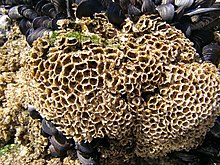
Nereis is a genus of polychaete worms in the family Nereididae. It comprises many species, most of which are marine. Nereis possess setae and parapodia for locomotion and gas exchange. They may have two types of setae, which are found on the parapodia. Acicular setae provide support. Locomotor setae are for crawling, and are the bristles that are visible on the exterior of the Polychaeta. They are cylindrical in shape, found not only in sandy areas, and they are adapted to burrow. They often cling to seagrass (posidonia) or other grass on rocks and sometimes gather in large groups.

The Terebellidae is a marine family of polychaete worms, of which the type taxon is Terebella, described by Carl Linnaeus in his 1767 12th edition of Systema Naturae.

Spirobranchus giganteus, commonly known as the Christmas tree worm, is a tube-building polychaete worm belonging to the family Serpulidae.

The Serpulidae are a family of sessile, tube-building annelid worms in the class Polychaeta. The members of this family differ from other sabellid tube worms in that they have a specialized operculum that blocks the entrance of their tubes when they withdraw into the tubes. In addition, serpulids secrete tubes of calcium carbonate. Serpulids are the most important biomineralizers among annelids. About 300 species in the family Serpulidae are known, all but one of which live in saline waters. The earliest serpulids are known from the Permian.
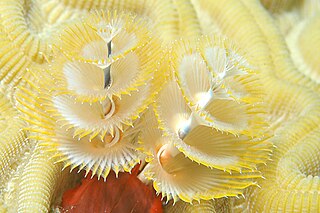
Spirobranchus is a small genus of tube-building annelid fanworms in the family Serpulidae.
Harmothoe is a genus of marine Polychaete worms belonging to the family Polynoidae. Species of Harmothoe are found world-wide to depths of at least 5,000 m but are more common in shallower water.

Ampharetinae are a subfamily of terebellid "bristle worm". They are the largest subfamily of the Ampharetidae, of which they contain the great majority of the described genera.
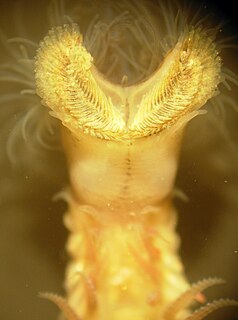
Sabellaria alveolata,, is a reef-forming polychaete. It is distributed around the Mediterranean Sea, and from the north Atlantic Ocean to south Morocco. It is also found in the British Isles at its northern limit in the northeast Atlantic. Its common name is derived from the honeycomb-like pattern it creates when building its tube reefs.

Ampharete is a genus of polychaete annelid worms. They have a single, chevron-shaped row of teeth.

Phyllodoce is a genus of polychaete worms, which contains about 200 species. The prostomium bears eyes, two pairs of antennae and a pair of large retractile nuchal organs. The eversible proboscis is clearly divided into two parts.

Serpula vermicularis, known by common names including the calcareous tubeworm, fan worm, plume worm or red tube worm, is a species of segmented marine polychaete worm in the family Serpulidae. It is the type species of the genus Serpula and was first described by Carl Linnaeus in his 1767 12th edition of Systema Naturae. It lives in a tube into which it can retract.

Sabellaria spinulosa is a species of marine polychaete worm in the family Sabellariidae, commonly known as the Ross worm. It lives in a tube built of sand, gravel and pieces of shell.

Diopatra is a genus of polychaete worms in the family Onuphidae.

Amphinomidae, also known as the bristle worms or sea mice, are a family of marine polychaetes, many species of which bear chaetae mineralized with carbonate. The best-known amphinomids are the fireworms, which can cause great pain if their toxin-coated chaetae are touched or trodden on. Their relationship to other polychaete groups is somewhat poorly resolved.
Salmacina dysteri is a species of tube-forming annelid worm in the family Serpulidae. It is found on submerged rocks, reefs, piles and boats in many shallow and deeper water environments around the world.
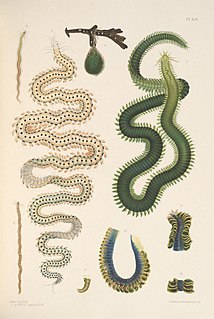
Eulalia is a genus of polychaete worms.
Phyllochaetopterus is a genus of marine polychaete worms that live in tubes that they construct.
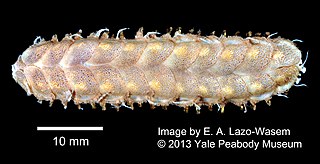
Lepidonotus is a genus of marine annelids in the family Polynoidae. The genus occurs globally and includes 80 species, usually found in shallow waters down to about 80 metres.
Lumbrineris is a genus of polychaetes belonging to the family Lumbrineridae.
